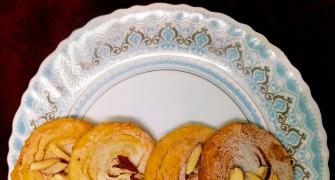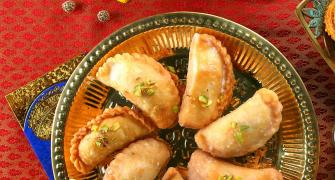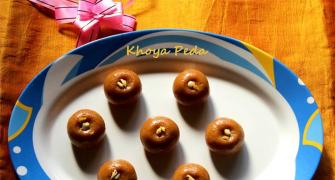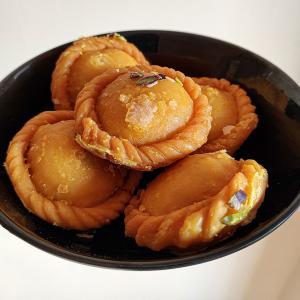A treasure of traditional Diwali recipes from all corners of our India.
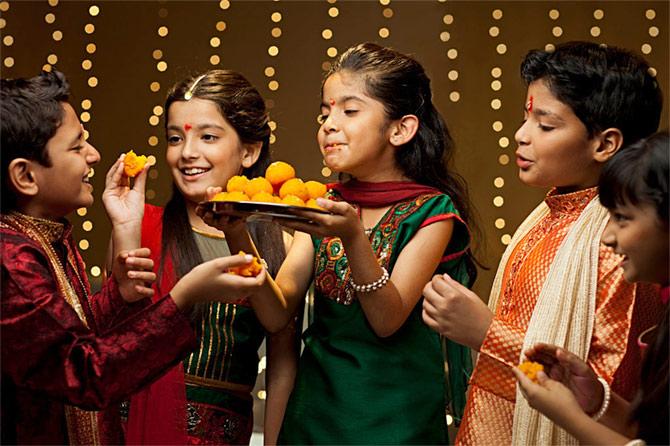
A fortnight before the Diwali festivities begin, housewives all over India set about sweeping and scrubbing down their houses. Many have their homes repainted with sparkling white chuna or lime. The practical angle of this being that the home and the kitchen is cleared of any dirt or micro-organisms that may have accumulated after a sweltering, hot summer and a long, humid monsoon.
And then, the herculean tasks of grinding, roasting, rolling, chopping, frying and basting to produce huge baskets of sweets begin.
Nuts are ground to a fine powder and kneaded with sugar, ghee or clarified butter and khoya (a type of milk solid) to make barfis. Besan or chickpea or gram flour is roasted in ghee and thickened with sugar syrup to make besan laddus.
Maida ka dough is rolled out into all imaginable shapes, stuffed with raisins and grated cocounut, deep fried and then coated with sugar. And a legion of fragrant laddus, khajas, barfis and balushais emerge from the kitchens of every home.
Most of these recipes have been handed down over generations. Which is why, it is quite possible that, for the last five decades, besan laddus have been made in exactly the same manner.
Each region in India is famous for its own variety of sweets made specifically for Diwali.
A collection of sweet recipes from the various states and regions of India, including the former province of Sindh, where Diwali is celebrated.
These are all recipes for homemade sweets collected from grannies and ammas and housewives in the know. And they are all very traditional -- one hundred per cent!
Shubh Deepavali, Dear Readers!
| Bihar | Maharashtra | Rajasthan |
| Gujarat | Mangalore | Sindh |
| Haryana | Palakkad | Tamil Nadu |
| Madhya Pradesh | Punjab | Uttar Pradesh |

These chickpea or besan balls are savoured with great relish all over the North, as well as Bihar and is a favourite at all auspiscious functions.
Servings: 20-25
Ingredients
- 500 gm besan or chickpea or gram flour, sifted
- 500 gm ground sugar or icing sugar
- 200 gm ghee + extra for rolling the laddus
- 1 tsp elaichi or green cardamom powder
Method
- In a frying pan or kadhai, heat the ghee until it smokes, then lower the heat.
Add the besan and fry on a medium heat until it is a golden colour.
Take off the heat and add the sugar.
Mix. - When it is cooled to a comfortable temperature, grease your palms with ghee and form the mixture into 2-cm diameter balls.
Keep aside to cool and harden. - Store in air-tight containers -- these will keep for several days

This is a typical sweet especially made for Diwali in many states, but it is known by different names. Though the ingredients are quite common, this delicate mithai, requires technique to turn out right!
This is placed as an offering for the Lakshmi puja as well as served as prasad. In Maharashtra, they make it this way:
Servings: 15
Ingredients
- ½ kg rice
- ¾ kg gud or jaggery, crumbled
- 3-4 tbsp khus-khus or poppy seeds
- 250 gm ghee, for frying
Method
- Grind rice into fine flour in a mixer.
- In a bowl, knead the gud and flour.
Make flattened balls of about 2 cm in diameter.
Roll out into thick rounds, approximately 3 inches in diameter.
Sprinkle poppy seeds on top of the rounds. - Heat the ghee till quite hot in a deep frying pan or kadhai.
In piping hot ghee, lightly fry the rounds - Drain from the ghee and place in a channi or colander to drain off any further excess ghee.
Take care, as the delicate texture may break.

This is the Rajasthani version of malpua but it is made slightly differently. Served with cream or garnished with pista, it is a Diwali favourite.
Serves: 5
Ingredients
- 1 cup sugar
- 1½ cups aata or wheat flour
- 4 tbsp yoghurt or curd
- 10-15 whole black peppercorns
- Milk
- Water
- Oil for deep frying
- Pista, for serving
- Cream, for serving
Method
- In a bowl, make a batter of all of these dry ingredients and the yoghurt, adding ½ milk and ½ water till it is thick and of pouring consistency, similar to pancake or dosa batter.
Whip till smooth.
Add the 10 peppercorns. - Keep aside and allow it to rise for about 2 hours.
- Heat the oil in a deep frying pan or kadhai over medium heat.
Drop large ladlefuls of the batter into the oil to form circles of 6-8 inches.
Typically the dough will sink and line the bottom of the kadhai and rise up in the shape of a disc.
Fry till golden.
Drain onto a tissue or paper towel-lined plate and pat off the oil. - Serve with cream or garnished with pista.

One of the most popular sweets served by Gujaratis during Diwali or on the New Year, the day after Diwali.
Servings: 30
Ingredients
- 500 gm besan or chickpea or gram flour, sifted
- 250 gm sugar
- 250 ml water
- 50 gm khoya or milk solids (khoya is made by reducing a large volume of milk to a solid by very slow boiling, for many hours; about 3 litres of milk will produce hardly 200-300 gms of khoya)
- 10 almonds peeled and blanched
- 10 pistachios blanched
- 2 tsp elaichi or green cardamom powder
- 250 gm ghee
- Oil for greasing the plate
Method
- In a bowl, mix the chickpea flour or besan with ½ of the ghee.
- In a kadhai or wok warm the rest of the ghee and add the besan-ghee mixture.
Fry till besan is golden but not brown.
Add the khoya.
Stir over low heat.
Keep aside. - Make a sugar syrup of one thread consistency with 250.
Add the syrup and cardamom powder to the fried besan.
Mix well.
Pour on a plate that has been greased with oil. - Decorate with blanched pistas and almonds.
Cut into diamonds. - Allow it to cool.
Editor's Note: One-thread consistency sugar syrup: It is important to keep testing for consistency while the sugar syrup is boiling.
The test for this is: Dip a spatula, preferably wooden, into the boiling sugar syrup and take out.
Some syrup would have coated the spatula.
Let it cool.
Touch the cooled syrup with your forefinger. Some syrup will come onto your finger.
Touch that with your thumb and separate thumb from forefinger.
When one little continuous delicate thread is formed by the syrup, when the coated forefinger is pulled away from your thumb, you have a one-string or one-thread consistency sugar syrup.

A typical sweet of the Konkan belt, these laddus are made from rice flour and jaggery.
Servings: 20
Ingredients
- ½ kg uncooked boiled rice, washed and dried in the sun.
- ½ kg jaggery
- 2 tbsp ghee + extra for the laddus
- 2 fresh coconuts, grated
- 6 pods green cardamom or elaichi, powdered
Method
- Dry roast the boiled rice till crisp on a tawa or griddle and grind to a coarse flour.
- Pound the grated coconut with a masher or in a mortar pestle.
In a bowl, mix the pounded coconut with the jaggery, which has been gently melted to syrup over low heat.
Add in the ground rice and cardamom powder and mix well. - Apply the ghee to your palms and make into 3-inch balls.
- Cool and store in an air-tight container.

A very traditional Sindhi sweet, this dryish halwa should ideally be eaten hot and fresh. Kuti is cooked for most Sindhi festivals and pujas and for Diwali too.
Serves: 5-8
Ingredients
- ½ kg aata or wheat flour
- ¼ kg ghee
- ¼ kg sugar
- 10-15 almonds
- 5-6 elaichi or green cardamom pods, powdered
Method
- In a frying pan or kadhai, heat the ghee gently over low heat.
Add the wheat flour and keep frying over medium heat till golden brown and dryish.
Take off heat. - Mix in the sugar, the cardamom powder and the finely chopped almonds.
- Serve immediately.

This yummy sweet, a kind of a fudge made from rice flour, is a must for Diwali in Haryana and Punjab. If properly made and stored, it will keep for several days!
Servings: 8-10
Ingredients
- 250 gm ground rice flour
- 175 gm bhurra or powdered mishri sugar (or powdered ordinary sugar if mishri is not available)
- 100 gm ghee
- 25 gm raisins
- 25 gm meva or a mix of chopped dried fruit and nuts -- cashews, almonds, pistachios and dates
Method
- In a frying pan or kadhai or wok roast the rice flour with ghee over low heat.
Let it not burn or get 'coloured but let it roast till it gives of a bit of an aroma and then take off the heat.
Add in powdered sugar, raisins and chopped nuts. - When it has cooled a little, and you can handle it safely without getting burnt, take a fistful and press into an oblong shape.
Your fingers will leave a a ridged imprint pattern. - Store or serve when completely cooled.

Parts of northern and central Kerala are the only areas of the state where Diwali is celebrated. Residents of Palakkad have special rituals and cuisine that are very particular to their community. Rawa Laddus are standard Diwali fare.
Servings: 18-20
Ingredients
- 2 cups rawa or semolina from rice
- 3 cup sugar
- ¼ litre milk + extra for rolling the laddus
- 10 pods elaichi or green cardamom, powdered
- 10 cashews, broken and fried golden
- 20 raisins, deep fried
- 5 tbsp ghee
Method
- Roast the semolina or rawa on a tawa or griddle with 3 tbsp of the ghee over low heat till pink.
Keep aside. - In a saucepan, make a thick syrup of sugar and milk of about one-thread consistency.
Add the ghee-roasted semolina to the syrup and the remaining 2 tbsp ghee, cardamom powder, cashews, raisins.
Cook till quite thick. - Coat your palms with a little cold milk.
And make little balls or laddus of 2-inch diameter while the mixture is still warm.
Cool and store in air tight containers.
Editor's Note: One-thread consistency sugar syrup: It is important to keep testing for consistency while the sugar syrup is boiling.
The test for this is: Dip a spatula, preferably wooden, into the boiling sugar syrup and take out.
Some syrup would have coated the spatula.
Let it cool.
Touch the cooled syrup with your forefinger. Some syrup will come onto your finger.
Touch that with your thumb and separate thumb from forefinger.
When one little continuous delicate thread is formed by the syrup, when the coated forefinger is pulled away from your thumb, you have a one-string or one-thread consistency sugar syrup.

This is a sweet rice preparation from Tamil Nadu, which can be stored in air-tight tins, through all the days of Diwali
Servings: 10-12
Ingredients
- 1 cup raw rice, wash and soak in water for 1 hour
- 1 cup jaggery
- ½ tbsp khus-khus or poppy seeds
- ½ tbsp til or sesame seeds
- 4 small pods elaichi or green cardamom, powdered
- Oil for deep frying + extra for rolling the balls
Method
- Drain and pound or grind the rice to a fine powder in batches in a mortar and pestle or else coarsely grind it in a mixer.
Keep aside. - On a tawa or flat pan, (griddle) roast the til and the khus-khus over low heat.
Add to the powdered rice.
Mix and then spread out on a flat plate to cool for about 10 minutes. - In a saucepan, heat the jaggery over medium heat till it becomes a syrup.
Add the rice flour mixture and keep stirring.
Add the cardamom or elaichi powder.
Take off heat and let cool. - Grease your palms with a little oil and make 3-inch diameter balls of the mixture.
Flatten them lightly with your palm. - In a kadhai or wok, heat the oil till very hot.
Deep fry these discs tills crisp and brown.
Drain onto a tissue or paper towel-lined plate.
Serve warm or store.

Balushais, khasta or crumbly doughnuts without holes are part of the traditional offerings at Diwali in Madhya Pradesh, Uttarakhand, Uttar Pradesh and Bengal for Kali Puja.
Servings: 15-20
Ingredients
- 500 gm maida or all-purpose flour
- Pinch baking soda
- ½ tsp baking powder
- 200 gm thick fresh yoghurt or curd
- 500 gm sugar
- 6 cups water
- Ghee for deep frying
Method
- Sift the flour, baking powder, baking soda through a sieve.
Keep aside. - In a large bowl, cream the yoghurt and 100 gm of the sugar.
Gently and lightly, knead in the flour mixture to the yoghurt mixture.
Do not do it vigorously.
Keep the dough aside for an hour and allow it to rise. - In a saucepan, boil the sugar and the remaining 400 gm sugar over medium heat, till it has a two-thread or string consistency.
Keep aside but keep warm. - Knead dough lightly, once again.
Divide it into small 3-inch diameter balls.
Flatten the balls by pressing lightly.
Make a depression in the centre of each with your thumb. - In a kadhai or wok, heat the ghee, for deep frying.
Lower the heat and deep fry the dough cakes or balushais, 2-3 at a time allowing room for them to expand.
Ladle ghee over the balushais as you fry.
They will puff out and almost double in size.
Fry them till they are a light biscuit colour. - Drain from the ghee, one by one, with a slotted spoon or jhariya.
Drain off the extra ghee by holding the slotted spoon against the rim of the kadhai.
Slip the balushais into the sugar syrup or chaasni.
When well soaked, drain and keep aside to cool.
As they cool they will have a thin sugar-coating on each balushai. - Serve warm or store.
Editor's Note: Two-thread consistency sugar syrup: It is important to keep testing for consistency while the sugar syrup is boiling.
The test for this is: Dip a spatula, preferably wooden, into the boiling sugar syrup and take out.
Some syrup would have coated the spatula.
Let it cool.
Touch the cooled syrup with your forefinger. Some syrup will come onto your finger.
Touch that with your thumb and separate thumb from forefinger.
When two little continuous delicate threads are formed by the syrup, when the coated forefinger is pulled away from your thumb, you have a two-string or two-thread consistency sugar syrup.

This milk fudge is a favourite all over India. At Diwali, pedhas are a must in both, Uttar Pradesh as well as in Punjab. They are also known as peda or penda in other states.
Servings: 20
Ingredients
- ½ kg khoya or milk solids (khoya is made by reducing a large volume of milk to a solid by very slow boiling for many hours; about 3 litres of milk will produce hardly 200-300 gms of khoya)
- 250 gm ground sugar
- 250 gm milk + extra for mixing the safron or rose essence
- 2 drops rose essence or a few strands kesar or saffron
- 2 tbsp almonds, finely slivered
- 2 tbsp pistachios, finely slivered
- 1 tsp elaichi or green cardamom powder
Method
- Mix the khoya and sugar well, and warm it in a heavy-bottomed frying pan or kadhai over medium heat.
Add 2 tbsp of the milk and stir with a heavy ladle smoothening out any lumps.
Continue stirring and add more milk, little by little, till all the milk is used up.
Lower the heat, if it sticks to the bottom of the pan or kadhai.
Add the rose essence or saffron dissolved in milk to the khoya-sugar-milk mixture, and take off heat.
Mix the flavouring and khoya properly.
Let it cool. - In a plate, mix the finely slivered nuts with the cardamom or elaichi powder.
Make small balls of about 2 cm diameter of the still warm khoya mixture and press on the elaichi-flavoured nuts for decoration.
You can also make depressions along the edges with a tsp handle or other stamp moulds for surface designs.

No festival in the northern and central states of India is complete without these laddus. Though traditionally made at weddings and sent to friends and relatives Bundi Laddus,< as they are also called, are auspicious This is how this laddu is made in Uttar Pradesh and Madhya Pradesh. Making them is a difficult and time-consuming and if you are successful it's a feat.
Servings: 20-25
Ingredients
- ½ kg besan or chickpea or gram flour
- ½ kg sugar
- 500 ml water
- Pinch baking soda
- ¼ cup milk
- Water
- Few drops orange colouring
- Few drops saffron or kesar essence
- 2 tbsp finely sliced almonds
- 2 tsp elaichi or green cardamom powder
- Ghee for deep frying + 2 tbsp for the batter
- A perforated ladle or spoon or large jhariya, with tiny holes
- Oil for rolling the laddus
- Vark or silver foil, for garnish
Method
- Into a large bowl, sift the besan and the baking powder.
Mix in 2 tbsp melted ghee, milk and enough water to make a thickish batter. - Heat enough ghee in a kadhai or wok for deep frying the besan batter miniature balls.
When the ghee is smoking hot, take the perforated spoon and with one hand, hold it over the kadhai.
With the other hand, rub some batter through the perforations in the ladle.
The batter will fall in tiny droplets.
Tap the ladle handle against the rim of the kadhai to help it fall through.
Fry these droplets till they are golden.
Take these boondis out with another perforated spoon or ladle, resting it on the rim of the kadhai, so that the extra ghee can drip down back into the kadhai.
Fry the rest of the boondi batter in the same way. - In a saucepan boil the water and the sugar over medium heat to get a sugar syrup of a three-thread consistency.
Add colour and the essence.
Keep this syrup hot.
Add the fried boondis into the syrup along with the almonds, elaichi powder and mix thoroughly. - Allow it to cool.
- When it has cooled enough to touch, form into round 2-cm diameter balls with greased palms.
Apply a layer of chandani vark or special silver foil to them , if you wish. - These laddus will be quite soft. If you want harder ones, cook the syrup till it is of 'hard-ball' consistency.
Editor's Note: Three-thread consistency sugar syrup: It is important to keep testing for consistency while the sugar syrup is boiling.
The test for this is: Dip a spatula, preferably wooden, into the boiling sugar syrup and take out.
Some syrup would have coated the spatula.
Let it cool.
Touch the cooled syrup with your forefinger. Some syrup will come onto your finger.
Touch that with your thumb and separate thumb from forefinger.
When three little continuous delicate threads are formed by the syrup, when the coated forefinger is pulled away from your thumb, you have a three-string or three-thread consistency sugar syrup.
For hard ball sugar syrup, boil the syrup a little longer.
Keep a small bowl of cold water handy.
Drop a tsp of the sugar syrup into the bowl of water and when it slightly cools see if it is malleable enough to mould into a ball.
Take out of the water and allow the ball to cool and if it hardens the sugar syrup is ready.
If the balls remains soft, cook the syrup a little longer.
Happy Diwali!


